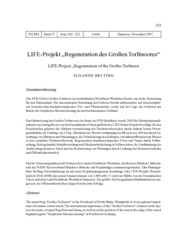LIFE-Projekt „Regeneration des Großen Torfmoores“
Belting, Susanne
37: 203 - 222
Belting, Susanne, 2007: LIFE-Projekt „Regeneration des Großen Torfmoores“. In: TELMA - Berichte der Deutschen Gesellschaft für Moor- und Torfkunde, Band 37: 203 - 222, DOI: 10.23689/fidgeo-3025.
 |
Dokument öffnen: |
Abstract:
The raised bog “Großes Torfmoor“ in the Northeast of North-Rhine Westphalia is of exceptional importance for nature conservation. The international importance of the “Großes Torfmoor“ is based on the species diversity of raised bog flora and fauna, as well as on the position of the area at the edge of the raised bogland region “Diepholzer Moorniederung“ in Northwest Germany.
In 2003 the European Union accepted the application for the LIFE project for optimising the Großes Torfmoor. The LIFE project is co-ordinated and monitored by representatives of the Council of Kreis Minden-Lübbecke, the regional administration of Detmold and supported by the Ministry of Environment and Nature Conservation. The Naturschutzbund Deutschland Kreisverband Minden-Lübbecke (NGO) is the project leader. Belting Umweltplanung, a company for environmental planning, is engaged in the project management. The LIFE project is financed by North-Rhine Westphalia and the European Union, each contributing fifty percent of the funding.
The finance of h1,800,400 is used from 2003 until 2008 for the following measures:
• Rounding off a larger area of bog and peatland by purchasing the last missing plots from private
owners (15ha)
• Termination of the re-wetting of 430ha of bog by installing small dams and blocking ditches
• Regeneration of the bog vegetation and fauna by clearing, mowing, grazing by a herd of moorland
sheep and levelling of some upper plots by caterpillar vehicle (JCB)
• Reduction of disturbance to the bog by directing visitors and public relations work
• Stopping the nutrient-contaminated water from seeping into the central bog
• Reduction of the spread of invasive species
Most of the intended measures have been completed and the monitoring of this project has shown
progress. Zusammenfassung:
Das FFH-Gebiet Großes Torfmoor im nordöstlichen Nordrhein-Westfalen besitzt eine hohe Bedeutung für den Naturschutz. Die internationale Bedeutung des Gebietes beruht insbesondere auf dem kompletten Arteninventar hochmoortypischer Tier- und Pflanzenarten, sowie auf der Lage des Gebietes am Rande der Diepholzer Moorniederung im nordwestdeutschen Tiefland.
Zur Optimierung des Großen Torfmoores im Sinne der FFH-Richtlinie wurde 2003 für Naturschutzmaßnahmen ein Antrag für ein von der Europäischen Union gefördertes LIFE-Natur-Projekt bewilligt. Zu den Projektzielen gehören die Flächen-Arrondierung des Hochmoorbereiches durch Ankauf letzter Privatgrundstücke im Umfang von 15 ha, Abschluss der Wiedervernässung des Moores (ca. 430 ha) durch Errichtung von Dämmen und Stauanlagen, die Verhinderung des Zuflusses von nährstoffbelastetem Wasser in den zentralen Hochmoorbereich, Regeneration hochmoortypischer Flora und Fauna durch Entbuschung, Schlegelmahd, Schafbeweidung und Flächenabschiebung in Teilbereichen, die Eindämmung der Ausbreitung invasiver Arten und die Reduzierung von Störungen durch Lenkung des Besucherverkehrs und Öffentlichkeitsarbeit.
Für die Umsetzung haben sich Vertreter des Landes Nordrhein-Westfalen, des Kreises Minden-Lübbecke und der NABU Kreisverband Minden-Lübbecke als Projektträger zusammengefunden. Das Planungsbüro Belting Umweltplanung ist mit dem Projektmanagement beauftragt. Das LIFE-Projekt (Projektlaufzeit 2003-2008) mit einem Finanzvolumen von 1.800.400,- h wird zur Hälfte von der Europäischen Union und dem Land Nordrhein-Westfalen finanziert. Der größte Teil der geplanten Maßnahmen ist umgesetzt, die Effizienzkontrollen zeigen bereits erste Erfolge.

